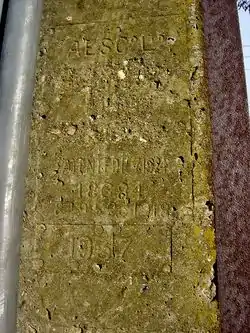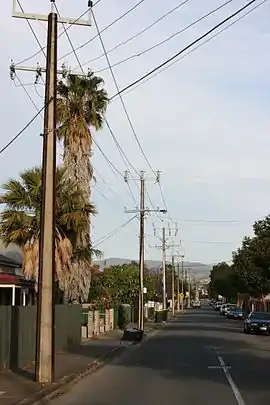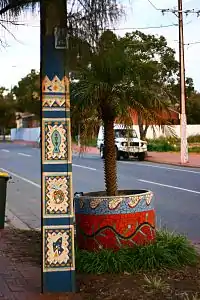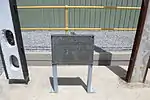Stobie pole
A Stobie pole is a power line pole made of two steel joists held apart by a slab of concrete. It was invented by Adelaide Electric Supply Company engineer James Cyril Stobie (1895–1953).[2] Stobie used readily available materials due to the shortage of suitably long, strong, straight and termite-resistant timber in South Australia.




History
In July 1924 the patent application for the pole design was submitted in both English and French, and accepted in November 1925. Stobie described his invention as
"an improved pole adopted to be used for very many purposes, but particularly for carrying electric cables, telegraph wires... [it] consists of two flanged beams of iron or steel, preferably rolled steel joist of 'H' or of channel sections, placed one beside the other with their flanges inward and preferably at a very slight angle one with the other and held together by means of tie bolts, the space between them being filled with cement concrete."[3]
A second patent was granted to Stobie and Frederick William Herbert Weadon in 1946. With John Ragless Brookman they formed The Stobie Pole Syndicate[4] for the purpose of patenting the design and then selling the patent or manufacturing rights. The Hume Pipe Company became their first agents and, while there were numerous international enquiries, South Australia remains the only place where they are widely used.[3]
Installations
Stobie poles are reasonably common in Broken Hill, as well as the Darwin CBD and a few thousand are installed across Tasmania. A few also exist in Canberra[5] and isolated settlements in the Goldfields-Esperance region of Western Australia such as Eucla and Rawlinna.
The first poles were erected in South Terrace, Adelaide in 1924, and were then used extensively in building the electricity transmission and distribution infrastructure throughout the state. The Stobie pole was central to the speedy expansion of Adelaide Electricity Supply Company's supply. It was cheap and simple to produce, had a uniform appearance, saved an enormous amount of timber from being harvested, had a long life expectancy and, at the time, was seen as more environmentally sensitive.[3] SA Power Networks review alternative pole designs available on the market and has yet to find one with the benefits offered by the Stobie pole.
Design
The poles carry supply voltages from 240 to 275,000 volts and come in various sizes from 9 to 26 metres in length, though studies indicate heights to 36 metres are feasible.[6] The service life of a Stobie pole is predicted to be in excess of 80 years. It is now commonly regarded as a South Australian icon.[7] SA Power Networks manufactures Stobie poles at a plant in Angle Park, South Australia.
Its modern construction is a composite of two steel beams connected intermittently by bolts to manage compressive buckling, with the gap between the beams filled with concrete. The bolts transfer the shear, with an equal number of bolts above and below ground. The poles are tapered from ground level to the top and the toe. This construction uses the tensile properties of the steel, giving the poles excellent properties in bending. Stobie pole strength in the strong direction may be up to 4.5 times the weak direction strength.[8] Small holes through the concrete enable attachment of modular cross-arms, insulators and other hardware. The poles are fireproof, rotproof, and termiteproof. Stobie poles are widely regarded in Australia to be dangerous to vehicles, with collisions sometimes "almost cutting the vehicle in half."[9][10][11]
Stobie pole designs are calculated to ensure the installation uses a suitably sized pole. Factors such as physical mass (static load) of transformers, cross beams, voltage regulators, protection devices, conductors (including tension), etc. are considered, and the wind loading (dynamic load) of this equipment must also be calculated. In some cases the wind loading factors far exceed the static load values.[8]
Artistic use
Attempts have been made to beautify their appearance through Stobie pole gardens[12] and Stobie pole art projects.[13][14] Artist Clifton Pugh painted Adam and Eve in the Garden of Eden on a Stobie pole in 1984, but was subsequently asked to "cover up" the genitals on his painting.[15]
Some Adelaide primary and high schools have painted murals on Stobie poles located outside the schools.
See also
The Oppenheimer pole was a galvanized steel pole made in three telescopic sections for easy transport during the construction of the Australian Overland Telegraph Line in 1872.
 |
 |
 |
 |
 |
 |
 |
References
- The plaque between the poles reads: "A tribute to James Cyril Stobie M.E. Designer of the Stobie Pole. This pole, manufactured in 1924 and erected in the Templers-Freeling 33kV line was removed in 1959 and incorporated in this tribute in 1960."
- R. W. Linn, 'Stobie, James Cyril (1895–1953)', Australian Dictionary of Biography, Volume 16, Melbourne University Press, 2002, pp 314–315.
- Rob Linn, ETSA – The Story of Electricity in South Australia (1996) pp.38–39
- "Public Notices". The Advertiser. 16 November 1939. p. 8 – via trove.nla.gov.au.
Mentions James Cyril Stobie, Frederick William Herbert Weadon and John Ragless Brookman of Adelaide ... Engineers comprising the Stobie Pole Syndicate applying to extend the terms of two patents. - "On the hunt for suburban oddities and along St Georges Road in Melbourne". The Canberra Times. Retrieved 18 May 2020.
- McCormack, John Development of 36m Stobie Poles for 275kV Transmission Line accessed 22 April 2011
- Residents powerless to stop stobie poles being turned into mobile phone towers, Transcript of "Stateline" segment, Broadcast 11 April 2003, Reporter: Michael Smyth, Australian Broadcasting Corporation. Retrieved 17 January 2009.
- TS107 – Overhead Line Design Standard for Transmission & Distribution Systems, SA Power Networks
- Driver survives after wrapping a $250,000 Ferrari around a pole in Adelaide, 28 October 2008, archived from the original on 20 December 2008
- Woman seriously hurt in car crash at McLaren Vale (with photo), 29 September 2012
- http://www.theaustralian.com.au/news/doc-neeson-tells-sad-tale-of-an-angels-classic-from-his-hospital-bed/story-e6frg6n6-1226942787242
- Stobie Pole Gardens, Street Gardening, Re-earthing the Cities.
- Stobie Poles art project, City of Prospect, prospect.sa.gov.au
- Painted Stobie Poles, City of Prospect, prospect.sa.gov.au.
- Stobie Pole, Encyclopaedia of South Australian Culture, saculture.com.
External links
![]() Media related to Stobie poles at Wikimedia Commons
Media related to Stobie poles at Wikimedia Commons
